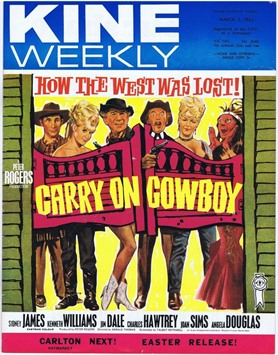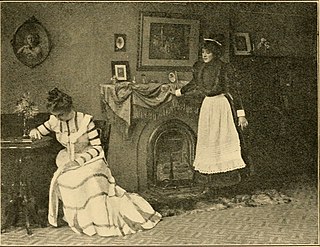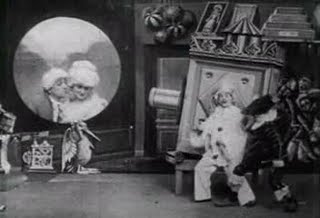
Bamforth & Co Ltd was a publishing, film and illustration company based in Holmfirth, West Yorkshire, England.

Bamforth & Co Ltd was a publishing, film and illustration company based in Holmfirth, West Yorkshire, England.
Bamforth & Co Ltd was started in 1870 by James Bamforth, a portrait photographer in Holmfirth, West Yorkshire. In 1883 he began to specialise in making lantern slides. [1] In 1898 the company started making silent monochrome films with the Riley Brothers of Bradford, West Yorkshire, who had been making films since 1896. James Bamforth's expertise with lantern slides proved invaluable in the film making. They used a camera developed by Bradford cine inventor Cecil Wray. [2] This partnership with Riley and Bamforth, known as "RAB Films" lasted until 1900. Though film production was restarted in 1913 it was again stopped in 1915, when the film production was changed to the newly named Holmfirth Producing Company, which quickly moved operations to London. The last Holmfirth film, Meg o' the Woods, emerged in February 1918.
In 1910 Bamforth & Co Ltd started making illustrated 'saucy' seaside postcards which, like its films, were exported worldwide for sale. The company was bought out by the Dennis Printing Company, of Scarborough during the early 1980s. Following the demise of Dennis the Bamforth & Co name, with postcards rights to over 50,000 designs, were purchased by Ian Wallace in 2001.
Although the Bamforth company was best known in the United Kingdom for producing a wide range of topographical and tourist postcards as well as 'saucy' seaside postcards, what is less well known was their rich history of filmmaking. Drawing heavily on their work with magic lantern cinema, the company began making monochrome films in 1898. The popularity of these films, in particular those featuring a character named Winky, led to a film industry in West Yorkshire which for a time surpassed that of Hollywood in terms of productivity and originality.
In September 2010, on the 100th anniversary of the original launch of the postcards, the new owner Ian Wallace relaunched the publication and sale of the postcards, with the Jane Evans Licensing Consultancy. [3] Currently Mercury Print & Packaging, in Leeds has the exclusive right to reprint and distribute [4]
|
|
|
|

Carry On is a British comedy franchise comprising thirty-one films, four Christmas specials, a television series, and stage shows produced between 1958 and 1992. Produced by Peter Rogers, the Carry On films were directed by Gerald Thomas and starred a regular ensemble that included Sid James, Kenneth Williams, Charles Hawtrey, Joan Sims, Kenneth Connor, Peter Butterworth, Hattie Jacques, Terry Scott, Bernard Bresslaw, Barbara Windsor, Jack Douglas, and Jim Dale. The humour of Carry On was in the British comic tradition of music hall and bawdy seaside postcards. The success of the series led to several spin-offs, including four Christmas television specials (1969–1973), a 1975 television series of thirteen episodes, and three West End stage shows that also toured the United Kingdom.

A postcard or post card is a piece of thick paper or thin cardboard, typically rectangular, intended for writing and mailing without an envelope. Non-rectangular shapes may also be used but are rare. There are novelty exceptions, such as wooden postcards, copper postcards sold in the Copper Country of the U.S. state of Michigan, and coconut "postcards" from tropical islands.

Holmfirth is a town in the Metropolitan Borough of Kirklees, West Yorkshire, England, on the A635 and A6024 in the Holme Valley, at the confluence of the River Holme and Ribble, 6 miles (9.7 km) south of Huddersfield and 14 miles (23 km) west of Barnsley. It mostly consists of stone-built cottages nestled on the eastern slopes of the Pennine hills. The boundary of the Peak District National Park is 2 miles (3.2 km) south-west of the town.
The year 1900 in film involved some significant events.

Edison Studios was an American film production organization, owned by companies controlled by inventor and entrepreneur, Thomas Edison. The studio made close to 1,200 films, as part of the Edison Manufacturing Company (1894–1911) and then Thomas A. Edison, Inc. (1911–1918), until the studio's closing in 1918. Of that number, 54 were feature length, and the remainder were shorts. All of the company's films have fallen into the public domain because they were released before 1928.
The Limelight Department was one of the world's first film studios, beginning in 1898, operated by The Salvation Army in Melbourne, Australia. The Limelight Department produced evangelistic material for use by the Salvation Army, including lantern slides as early as 1891, as well as private and government contracts. In its 19 years of operation, the Limelight Department produced about 300 films of various lengths, making it one of largest film producers of its time.

George Albert Smith was an English stage hypnotist, psychic, magic lantern lecturer, Fellow of the Royal Astronomical Society, inventor and a key member of the loose association of early film pioneers dubbed the Brighton School by French film historian Georges Sadoul. He is best known for his controversial work with Edmund Gurney at the Society for Psychical Research, his short films from 1897 to 1903, which pioneered film editing and close-ups, and his development of the first successful colour film process, Kinemacolor.

Robert William Paul was an English pioneer of film and scientific instrument maker.
Screen International is a British film magazine covering the international film business. It is published by Media Business Insight, a British B2B media company.

Kinematograph Weekly, popularly known as Kine Weekly, was a trade paper catering to the British film industry between 1889 and 1971.

Hungry Hearts (1922) is an American film based on stories by Anzia Yezierska about Jewish immigrants to the Lower East Side of New York City. The film was directed by E. Mason Hopper, produced by Samuel Goldwyn, and starred Helen Ferguson and E. Alyn Warren.

The Biter Bit is an 1899 British short black-and-white silent comedy film, produced by Bamforth & Co Ltd, featuring a boy playing a practical joke on a gardener by grasping his hose to stop the water flow and then letting go again when the gardener looks down it to check. The film, "is an English remake" of Auguste and Louis Lumière's L'Arroseur Arrosé (1895), according to Michael Brooke of BFI Screenonline, "providing a good illustration of how early film production companies cheerfully plagiarised each other's work" with "a few minor differences between, most notably a rather greater sense of space and depth in the Bamforth version" and "three distinct planes to the action". It is included in the BFI DVD Early Cinema: Primitives and Pioneers and a clip is used in Paul Merton's interactive guide to early British silent comedy How They Laughed on the BFI website.
Phantom rides or panoramas were an early genre of film popular in Britain and the US at the end of the 19th century. Pre-dating true narrative, the films simply show the progress of a vehicle moving forwards, usually shot by strapping a cameraman to the front. The term phantom ride was applied because the position of the camera meant that only the track and scenery could be seen and the movement appeared to be coming from an invisible force. Though many early films showed local tracks the demand for new footage led to more exotic locations being filmed. This brought a new dimension to the genre, showing foreign lands to those who would otherwise never see them. The genre is also significant, despite its short-lived popularity, due to the role it played in the development of the tracking shot, longer films and film editing, as well as its re-emergence in 4D film and simulation.
Charles Grigg more commonly known as Charlie Grigg was a British comic artist for DC Thomson. He was the artist of The Dandy cover strip Korky the Cat. He also drew Desperate Dan after the original artist, Dudley Watkins, died. In The Topper comic he drew Splodge, Willy Nilly, Foxy and Shorty Shambles.

A Terrible Night is an 1896 French silent comedy film by Georges Méliès. It was released by Méliès's Star Film Company and is numbered 26 in its catalogues, where it is listed with the descriptive subtitle scène comique.
Love Is All is a 2014 documentary film exploring the depiction of love and courtship on film throughout the 20th century. It is composed of archive material from the BFI National Archive, Yorkshire Film Archive and other sources.

Alexander Black (1859–1940) was an American author, photographer, newspaper man, and the inventor of the pre-cinema “Picture Play” which debuted in 1894.

Laura Eugenia Bayley was a British actress and filmmaker, active in the Brighton School of early cinema pioneers. Born in Ramsgate, Bayley performed onstage in Victorian burlesques, revues, and pantomimes, often with her three sisters. After marrying the showman George Albert Smith, she entered the world of early experiments with motion picture film; she played main roles in many of the most important films Smith made between 1897 and 1903, including The Kiss in the Tunnel (1899) and Mary Jane's Mishap (1903).

Gertie Brown Moore was a vaudeville performer and one of the first African-American film actresses. Brown is most famous for her part in the 1898 silent film Something Good – Negro Kiss, which went viral in 2018.

La Lanterne magique, sold in the United States as The Magic Lantern and in Britain as The Magic Lantern, or the Bioscope in the Toy Shop, is a 1903 French short silent film by Georges Méliès. It was sold by Méliès's Star Film Company and is numbered 520–524 in its catalogues.